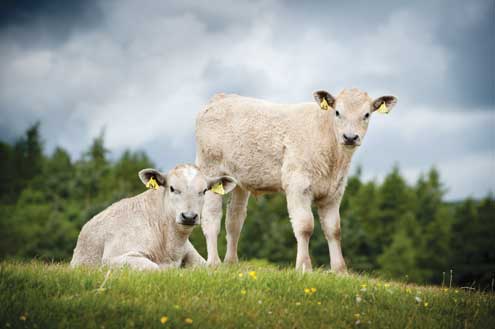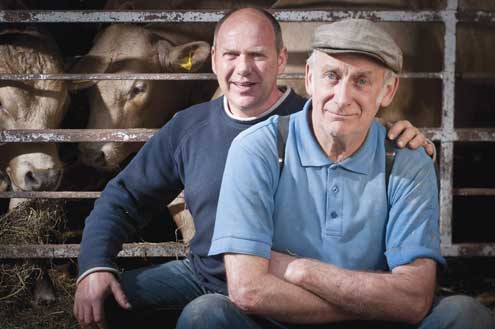Hitting beef finishing target success

| Hitting 1kg daily carcass gain carcass summary |
|---|
|
Farmers Weekly/Harper Adams Beef Focus farmer Simon Frost has just hit one of his lifetime targets for his suckler herd with a daily carcass gain (DCG) for his bull calves of 1kg from birth to slaughter.
The 2011 crop of calves recorded a carcass weight of 462kg at just 440 days (14.4 months) old – this is with 24kg removed to account for the calf birth carcass weight. With a kill-out of 59.8% (gut full), this equates to a live slaughter weight of 773kg and a daily liveweight gain of 1.66kg from birth – a phenomenal performance. And what makes this performance even more outstanding is that it includes bull calves from first-calved heifers, which are put to a very easy-calving Charolais bul.
I have been independently monitoring the herd and this is the best DCG I’ve ever seen. The typical DCG on many of the herds I monitor range from 0.70 to 0.80kg.
So how does Mr Frost achieve this tremendous performance?
The answer is by having a total focus on what we call the “golden triangle” of genetics, nutrition and health.
The suckler herd at Hopping Farm is based on small to medium-sized milky Limousin x Holstein-Friesian cows that are put to top 1% terminal index Charolais bulls. These bulls have been specifically selected to have positive calving ease direct estimated breeding values (EBVs), with very high 400-day growth and eye muscle area EBVs. These types of bulls are termed “curve-benders” and can be found within the Charolais as well as all other terminal sire breeds.
Mr Frost sells his calves at weaning to John and Alan Dore at Glapwell, near Chesterfield, who finish the high genetic merit cattle on a 16% CP home mix and good-quality big-bale silage.
The 2009, 2010 and 2011 calf crops
Steady progress has been made over the years with the finishing bulls. The 2009 bulls recorded a carcass weight of 438kg at 447 days old, equating to a DCG of 0.94kg. The 2010 bulls recorded a carcass weight of 427kg at 415 days old, equating to a DCG of 0.97kg and then finally the target of 1.00kg DCG was hit with the 2011 calf crop.
| Table 1: Simon Frosts suckled bull calf finishing results compared to the EBLEX target | |||
|---|---|---|---|
| EBLEX | 2010 | 2011 | |
| Slaughter age (months) | 14 | 13.6 | 14.4 |
| Slaughter weight (kg) | 590 | 714 | 773 |
| DLWG birth to slaughter (kg) | 1.28 | 1.62 | 1.66 |
| Kill out % | 59 | 59.9 | 59.9 |
| Carcass weight (kg) | 348 | 427 | 462 |
| DCG from birth (kg) | 0.77 | 0.97 | 1 |
| % E and U grades | n/a | 96 | 96 |
| Concentrates (kg/bull) | 1,500 | 1,384 | 1,662 |
| Silage (kg DM/bull) | n/a | 412 | 681 |
| FCR (kg feed DM:kg gain) | 5.3:1 | 4.7:1 | 4.9:1 |
The 2011 calves’ carcass weight of 462kg may be considered too heavy for a lot of retail outlets. But with the rising demand for beef these heavyweight carcasses are now seldom penalised, and if it is penalised it may only be a 10p/kg deduction for any weight in excess of 450kg.
The “shoe is now on the other foot”, with world demand for beef increasing. Some 44% of the bulls recorded a fat class of 4L, so they could easily be finished at lighter weights and still have decent fat cover.
Conformation
Mr Frost has hosted several groups of visiting farmers and some commented there were “too many R-grades” on visually assessing the finishing bulls. You will note from table 1 that only 4% graded R, the rest grading as E and U. I suspect these comments were made by finishers with what Mr Frost would describe as “inny-outy” cattle, that are relatively weak in the loin and shoulders in relation to the back end.
It should be remembered that conformation classification is based on assessing a carcass in three areas: shoulders, loin and back end. When a beast has a decent back end appropriate for a U+, but the loin and shoulders are weaker and graded -U, then the carcass will get an overall classification of -U. This is why some producers are disappointed with carcass grading results if they only look at the back ends of cattle.

Heavier carcass weights
The reason for the heavier carcass weights for this last batch of calves is simply attributed to them being “slower to get going”, according to finisher Mr Dore. One thing they do not do with the bull calves on arrival after weaning is push too much home-mix at them. It is all about minimising the calves’ stress when they are weaned by housing them – after they’ve been vaccinated – in well-ventilated, well-bedded straw yards, with double the recommended space allowance.
Top-quality silage is fed ad lib and home mix is gradually built up and by four weeks they are on 4kg, 6kg at six weeks and 8kg at eight weeks. The bulls start on top-quality dry 11.5ME big bale grass silage, but by January it is replaced with mature fibrous second cut with 9.8ME, which complements the high cereal feeding rate.
Feeding
When asked about the economics of intensive finishing Mr Dore says: “You have to feed to the potential.” The merits of intensive cereal finishing is a question frequently asked and I’m reluctant to suggest diluting down the energy density of ration for high-performance stock.
The main option to consider is replacing some cereal with very high-quality forage. Dramatically reducing cereal feed rate will reduce DCG, delay slaughter and generally increase overall finishing costs. The bulls eat on average 6.96kg of home-mix, plus 2.85kg silage DM from weaning to slaughter. From this you can calculate with your feed prices what it costs to put on 1kg of carcass weight a day and with your other daily variable and fixed costs you can judge for yourself if intensive finishing is economic.
Where next for Mr Frost?
Achieving 1kg DCG from birth to slaughter has been a long-term target for Mr Frost. And his main aim is always to maintain production at this level, while marrying it with ease of calving by use of EBVs. However, as long as he can maintain this, his next target will be 1.02kg. The question I would ask is: “How high can we go?”
Having got the health and nutrition spot on, Mr Frost attributes the improvement in DCG from 0.94 to 1kg over the past three years simply to “better bulls with higher indexes”.
Mr Frost has recently added to his bull stud with the purchase of Maerdy Grubby at Stirling in February. Grubby, a son of Blelack Digger, who is by the renowned Balthayock Adonis, has a calving ease direct of +12.9 (breed average is -0.9), a 400-day weight of +70kg (breed average is +42kg) and eye muscle area of +8sq cm (breed average is +3sq cm). Grubby has a top 1% terminal index of +83 and is a true “curve bender”. He should throw progeny that are very easily calved, with excellent growth. And since the eye muscle area EBV is one of the highest within the breed, he will produce E and U+ grade carcasses and help Mr Frost continue with the genetic improvement in his herd.
Heifer finishing results
The heifers – being a much earlier-maturing breed type – are finished on significantly lower levels of home-mix. This averages just 3kg a head a day of the same good-quality 16% CP home-mix based on barley, oats, hi-pro soya, linseed, molasses and minerals. This year a yeast culture was also fed.
| Table 2: Simon Frosts 2011 born suckled heifer calf finishing results | |
|---|---|
| Slaughter age (months) | 14.8 (450 days) |
| Slaughter wt (kg) | 550 |
| DLWG birth to slaughter (kg) | 1.14 |
| Kill out % | 56 |
| Carcass weight (kg) | 308 |
| DCG from birth (kg) | 0.64 |
| Conformation class | 4% E, 60% U, 34% R, 2% O+ |
| Fat class | 38% at 3, 58% at 4L, 4% at 4H |
| Concentrates (kg/head) | 789 + 1,038kg DM silage |
| FCR (kg feed DM/kg gain) | 6.5:1 |
The UK average heifer carcass weight in 2011 was 310kg at 690 days old. Mr Frost’s heifers finished 7.8 months younger than the UK average at similar carcass weights. It is of note that 96% were finished at fat class 3 and 4L, with only 4% finishing at fat class 4H, and 64% at E and U grades.
It is also worth noting that the difference in carcass weight between the bulls and heifers was a massive 154kg. At a carcass value of £3.70/kg, this is worth £570 in favour of the bulls. Based on feed costs of £215/t for home-mix and £100/t DM for good-quality silage, the bulls would have feed costs of £425 a head compared to £274 a head for the heifers – thus £151 more for the bulls. This still leaves a margin over feed in favour of the bulls of £419.
Serious consideration therefore needs to be given to the development and use of sexed male semen AI, especially in synchronisation programmes. Unfortunately it is currently not recommended to use sexed semen, which is predominantly sexed for heifers, in synchronisation programmes.
Look back at other articles detailing management practices at Hopping Farm
